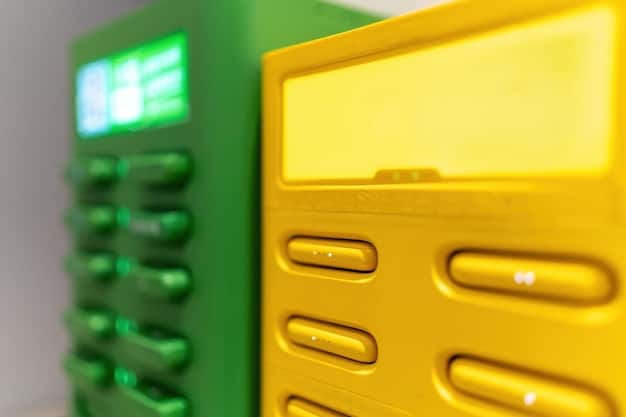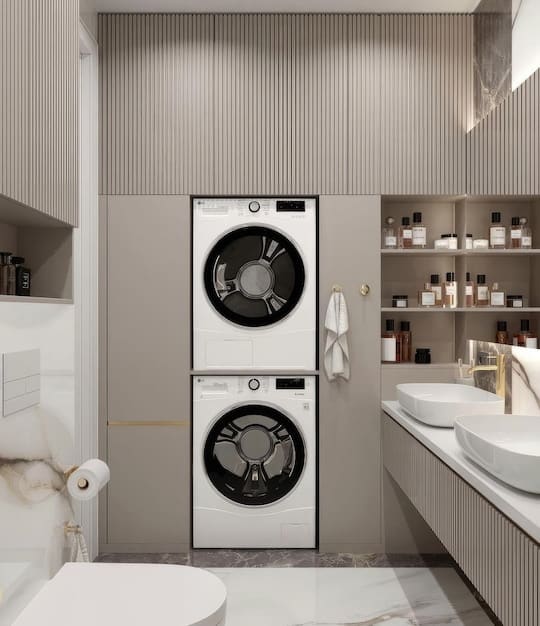Energy-Efficient Appliances: Save $200 Annually & Boost Sustainability

Choosing energy-efficient appliances is a strategic move, offering a tangible path to significant annual savings on utility bills, typically around $200, while actively promoting environmental sustainability and reducing your carbon footprint through conscious consumption.
In an era where both personal finance and environmental responsibility are paramount, understanding how to choose energy-efficient appliances and save $200 annually is more than just a smart decision—it’s a necessity. This guide delves into the practical steps and insights needed to make informed choices that benefit both your wallet and the planet.
The Imperative of Energy Efficiency in Modern Homes
The concept of energy efficiency in household appliances has evolved from a niche concern to a mainstream expectation. It’s no longer just about saving a few dollars; it’s about making a significant impact on your budget and a meaningful contribution to environmental sustainability. Every appliance you choose, from your refrigerator to your washing machine, carries an energy footprint that accumulates over its lifetime.
This section explores why prioritizing energy-efficient appliances has become a critical aspect of modern living, highlighting both the financial incentives and the broader environmental benefits. Understanding these underlying motivations is the first step towards making smarter purchasing decisions that resonate with your personal values and long-term financial goals.
Unveiling Hidden Costs: Beyond the Purchase Price
Many consumers focus solely on the upfront purchase price when buying new appliances. However, this perspective often overlooks the “hidden costs” associated with energy consumption. An appliance might be cheaper to buy, but if it’s an energy hog, it will ultimately cost you more over its operational lifespan through higher utility bills. This long-term cost can easily overshadow the initial savings.
- Lifetime Cost Analysis: Always consider the total cost of ownership, which includes the purchase price, maintenance, and projected energy consumption over the appliance’s lifespan.
- Energy as a Utility Bill Driver: Appliances are major contributors to household energy use, particularly those that run continuously or frequently, such as refrigerators, freezers, and water heaters.
- Inflation and Energy Prices: Energy costs can fluctuate and often trend upwards, meaning an appliance that is inefficient today will likely become even more expensive to operate in the future.
Environmental Stewardship: A Shared Responsibility
Beyond personal savings, choosing energy-efficient appliances is a proactive step towards environmental stewardship. Less energy consumption translates directly into reduced greenhouse gas emissions, mitigating climate change and lessening the strain on natural resources. It’s a tangible way for individuals to participate in the global effort towards a more sustainable future.
Moreover, the manufacturing processes of efficient appliances often involve less waste and more sustainable materials, contributing to a circular economy model. This holistic approach considers the entire lifecycle of a product, from production to disposal, minimizing its ecological footprint at every stage.
In essence, the decision to invest in energy-efficient appliances is a multi-faceted one, offering benefits that extend beyond the immediate financial realm. It embodies a commitment to prudent resource management, personal financial intelligence, and a healthier planet for future generations. This foundational understanding sets the stage for delving into the practical aspects of identifying and purchasing these beneficial household items, paving the way for tangible savings and a more sustainable lifestyle.
Decoding Labels: ENERGY STAR and Beyond
Navigating the world of energy-efficient appliances can seem daunting with various labels and metrics. However, understanding what these labels signify is crucial for making informed purchasing decisions that genuinely contribute to energy savings. The ENERGY STAR label is the most recognizable and reliable indicator of efficiency, but it’s important to look beyond just this single certification.
This section will demystify the key labels and ratings you’ll encounter, providing practical insights into how to interpret them and what specific criteria each represents. Equipping yourself with this knowledge will enable you to confidently identify appliances that meet your efficiency goals and contribute to the projected annual savings of around $200.
Understanding the ENERGY STAR Certification
The ENERGY STAR program is a joint initiative of the U.S. Environmental Protection Agency (EPA) and the U.S. Department of Energy (DOE). An ENERGY STAR certified appliance signifies that it meets strict energy efficiency guidelines set by these agencies. These products use less energy, save money, and help protect the environment.
- Performance Standards: ENERGY STAR qualified products must deliver the same or better performance than conventional models, ensuring you don’t sacrifice functionality for efficiency.
- Product Categories: The label covers a wide range of products, from refrigerators and washing machines to air conditioners and televisions, with specific criteria for each category.
- Continuous Improvement: The ENERGY STAR criteria are regularly updated to reflect advancements in technology, ensuring that certified products remain at the forefront of energy efficiency.
When you see the prominent blue ENERGY STAR logo, you can be assured that the product has undergone rigorous testing and certification processes. This eliminates much of the guesswork from your purchasing decision, making it a straightforward choice for energy savings.
The EnergyGuide Label: A Comparative Tool
While ENERGY STAR tells you an appliance is efficient, the yellow EnergyGuide label provides more detailed information, allowing for direct comparison between models. This label displays the estimated annual energy consumption (in kilowatt-hours per year) and the estimated annual operating cost of the appliance.
It also shows a sliding scale that indicates where the model falls in terms of energy consumption compared to similar models. The further to the left (lower end) of the scale the pointer is, the more energy-efficient the appliance. This label is mandatory for most major household appliances sold in the U.S.
Paying close attention to both the ENERGY STAR certification and the EnergyGuide label empowers you to make truly informed decisions. The former provides a quick confidence sign, while the latter offers the granular data required for a nuanced comparison. Together, they are your primary tools for selecting appliances that will help you achieve significant annual savings on your energy bills, contributing directly to the goal of saving an estimated $200 or more each year.

Strategic Appliance Upgrades for Maximum Savings
Simply choosing an energy-efficient appliance isn’t enough; strategic planning regarding which appliances to upgrade can significantly amplify your savings. Not all appliances consume energy equally, meaning some offer a much higher return on investment when replaced with more efficient models. Focusing your efforts on these high-impact items is key to achieving substantial annual reductions in your utility bills.
This section will guide you through prioritizing your appliance upgrades, identifying the “energy hogs” in your home, and understanding the typical savings associated with replacing them. By adopting a strategic approach, you can accelerate your journey towards saving that approximate $200 annually and beyond.
Identifying Your Home’s Energy Hogs
The biggest energy consumers in your home are typically those that run frequently or are responsible for heating/cooling. Replacing these first can lead to the most significant and immediate savings.
- Refrigerators: As they run 24/7, older models can consume a surprising amount of electricity. ENERGY STAR certified refrigerators are significantly more efficient.
- Washing Machines: They use both electricity for operation and hot water for washing. High-efficiency (HE) washing machines use less water and less energy to heat that water.
- Dishwashers: Similar to washing machines, dishwashers consume energy for heating water and for the drying cycle. Look for models with soil sensors and air-dry options.
- Water Heaters: While not typically considered an “appliance” in the same vein as a refrigerator, conventional tank water heaters are often the second-largest energy consumer after heating/cooling systems. Upgrading to a tankless or heat pump water heater can offer substantial savings.
By targeting these high-consumption appliances first, you ensure that your investment in efficiency yields the greatest financial benefits. It’s a targeted approach that maximizes the impact of each dollar spent on upgrading.
The ROI of Energy-Efficient Replacements
Understanding the return on investment (ROI) for energy-efficient appliances involves looking at the initial cost versus the long-term savings. While an energy-efficient model might have a higher purchase price, the reduced operating costs often lead to a payback period of just a few years, after which you continue to save money for the lifespan of the appliance.
For example, an old refrigerator might cost $150-$200 annually to operate, while a new ENERGY STAR model might only cost $50-$70. That’s a potential saving of $80-$150 per year from just one appliance. Multiply this across several key appliances, and the target of $200 in annual savings quickly becomes achievable, often surpassed.
Consider the lifespan of your current appliances. If they are more than 10-15 years old, their inefficiency is likely costing you significantly. A new energy-efficient model not only saves money but also offers improved performance, reliability, and modern features. Strategic upgrades are not merely replacements; they are investments in a more financially sound and environmentally friendly household.
Factors Beyond the Label: Making Smart Choices
While ENERGY STAR and EnergyGuide labels are indispensable tools, a truly intelligent decision on how to choose energy-efficient appliances and save $200 annually involves looking beyond these immediate indicators. Several other factors influence an appliance’s real-world energy consumption and its overall impact on your utility bills and lifestyle. Neglecting these can lead to unexpected higher costs or dissatisfaction.
This section delves into these nuanced considerations, from capacity and usage patterns to installation and maintenance. By incorporating these aspects into your decision-making process, you ensure that your chosen appliances are not only theoretically efficient but also perform optimally and cost-effectively in your specific home environment.
Sizing and Capacity: The Right Fit Matters
One of the most overlooked factors is choosing an appliance with the appropriate size and capacity for your household’s needs. An appliance that is too large for your family will often consume more energy than necessary, even if it’s an efficient model. Conversely, an appliance that is too small might be run more frequently, negating its efficiency.
- Refrigerators: A half-empty large refrigerator uses energy to cool unused space. Match its size to your typical grocery habits.
- Washing Machines/Dishwashers: Overfilling a small machine or running a large machine half-empty both waste energy and water. Consider how often you do laundry or wash dishes and choose a capacity that aligns with those habits for fewer, fuller loads.
- Air Conditioners: An oversized AC unit will short-cycle, consuming more energy and leading to uncomfortable humidity levels. A properly sized unit runs efficiently and cools effectively.
Accurate sizing ensures that the appliance operates at its peak efficiency, directly contributing to your savings goals by avoiding wasted energy from inappropriate usage.
Installation and Usage Habits: Maximizing Efficiency
An energy-efficient appliance can still be an energy hog if not installed correctly or used improperly. Correct installation and mindful usage habits are critical for realizing the full energy-saving potential.
For example, a refrigerator placed next to a heat source (like an oven or dishwasher) will work harder to maintain its internal temperature, thereby consuming more energy. Similarly, regularly cleaning filters in dishwashers, washing machines, and dryers improves their efficiency and longevity.
Your personal habits also play a significant role. Running full loads in the dishwasher and washing machine, opting for air-dry cycles where possible, and using delayed start features to utilize off-peak electricity rates (if available in your area) can significantly reduce energy consumption regardless of the appliance’s innate efficiency rating. These seemingly small adjustments combine to create a cumulative effect on your annual energy savings.
Beyond Purchase: Longevity and Maintenance for Sustained Savings
The journey to energy savings doesn’t end the moment you purchase and install your new, efficient appliance. To truly choose energy-efficient appliances and save $200 annually over the long term, you must consider their longevity and ongoing maintenance. An appliance that breaks down prematurely or operates inefficiently due to neglect will quickly erode any initial savings you achieved.
This section explores the critical role of proper care and long-term planning in maximizing the financial and environmental benefits of your energy-efficient investments. By committing to regular maintenance and understanding the lifespan of your appliances, you ensure that your initial smart purchase continues to pay dividends for years to come, solidifying your path to continuous savings.
The Lifespan of Energy-Efficient Appliances
While energy-efficient appliances are built to higher standards, their longevity can vary. Understanding the typical lifespan of different appliance types helps you plan for future replacements and factor in the long-term cost benefits. Manufacturers provide expected lifespans, and reputable brands often offer better durability.
- Refrigerators: Typically last 10-15 years.
- Washing Machines & Dryers: Average 10-13 years.
- Dishwashers: Expect 9-10 years.
- Ranges/Ovens: Can last 13-15 years, with electric typically outlasting gas models.
Investing in higher-quality, more durable models, even if they have a slightly higher upfront cost, can lead to greater overall savings. Fewer breakdowns and longer operational lifespans mean your investment in efficiency continues to yield returns without the burden of premature replacement costs.
Regular Maintenance: The Key to Sustained Efficiency
Just like a car, appliances require routine maintenance to perform at their best. Neglecting simple tasks can lead to decreased efficiency, higher energy consumption, and eventual breakdown. Consistent care ensures that your appliance continues to operate as intended, maximizing its energy savings.
For instance, cleaning refrigerator coils at least once a year improves its cooling efficiency. For washing machines, regularly cleaning the detergent dispenser and draining the filter prevents buildup that can strain the motor. Dishwashers benefit from periodic cleaning of filters and spray arms to ensure optimal water distribution and cleaning power.
Simple maintenance extends the life of your appliances and directly preserves their energy efficiency. It’s a proactive measure that saves you money on utility bills and avoids costly repairs or premature replacements, reinforcing the financial wisdom of choosing and maintaining energy-efficient appliances.
Government Incentives and Rebates: Funding Your Green Upgrade
Beyond the inherent long-term savings, understanding how to choose energy-efficient appliances and save $200 annually can be significantly enhanced by leveraging available government incentives and rebates. These programs, often overlooked by consumers, are designed to encourage the adoption of energy-efficient technologies, making the upfront investment more palatable and accelerating your return on investment.
This section will guide you through identifying and accessing these valuable financial aids, transforming your appliance upgrade into an even more cost-effective decision. By taking advantage of these opportunities, you not only reduce your personal financial burden but also contribute to broader energy conservation goals.
Federal Tax Credits and State Rebates
Both federal and state governments frequently offer programs to incentivize consumers to purchase energy-efficient products. These can come in various forms:
- Federal Tax Credits: The U.S. government periodically offers tax credits for certain energy-efficient home improvements, including specific categories of appliances like heat pump water heaters, central air conditioners, and furnaces. It’s crucial to check the IRS website or consult with a tax professional for the most current information and eligibility requirements.
- State and Local Rebates: Many states, counties, and even cities have their own rebate programs. These are often funded by utility companies and can offer significant cash back for purchasing ENERGY STAR certified appliances.
These incentives can substantially offset the initial purchase price, sometimes making the energy-efficient option cheaper in the short term than its less efficient counterpart. Always check eligibility requirements, application deadlines, and required documentation before making a purchase.
Websites like Energy.gov’s “Tax Credits, Rebates, & Savings” page are excellent starting points for finding relevant programs in your area. Leveraging these incentives can make the decision to invest in energy-efficient appliances an even smarter financial move, helping you reach your annual savings target faster.
Utility Company Programs and Discounts
Your local utility company is often a primary source for energy efficiency incentives. Recognizing the grid-wide benefits of reduced energy consumption, many utilities offer direct rebates, discounts, or even low-interest loans for customers who upgrade to energy-efficient appliances. These programs are designed to lower peak demand and reduce the need for new power generation.
Some utilities offer “instant rebates” at the point of sale through participating retailers, simplifying the process. Others may require you to submit an application after purchase. It’s highly recommended to visit your utility provider’s website or call their customer service to inquire about current residential energy efficiency programs. These programs are dynamic and can change frequently, so staying informed is key to maximizing your benefits, further cementing your ability to save that additional estimated $200 annually on your energy bills.
Behavioral Changes: Amplifying Your Appliance Savings
While investing in energy-efficient appliances is a foundational step, the true potential to choose energy-efficient appliances and save $200 annually is fully realized when combined with conscious behavioral changes. Even the most efficient refrigerator or washing machine can consume more energy than necessary if not used thoughtfully. Integrating smart habits into your daily routine can significantly amplify your savings, pushing you beyond the projected $200 mark.
This section highlights key behavioral adjustments and everyday practices that complement your efficient appliances, ensuring you maximize their benefits. These changes are often simple, cost nothing, and collectively contribute to a remarkably energy-lean household.
Smart Usage of Major Appliances
Your interaction with major appliances directly impacts their energy consumption. Small adjustments in how you use them can lead to significant savings.
- Washing Machines: Always run full loads. Use cold water whenever possible; heating water is the most energy-intensive part of the cycle. Opt for air-dry settings on your dryer or use a clothesline for even greater savings.
- Dishwashers: Run only full loads. Use eco-mode or air-dry options. Scrape food off plates instead of pre-rinsing under running water.
- Refrigerators/Freezers: Keep them full (but not overly packed) to help maintain temperature more efficiently. Don’t leave doors open unnecessarily. Ensure door seals are tight.
- Ovens: Avoid peeking by opening the door too often. Use smaller appliances like microwaves, toaster ovens, or slow cookers for smaller meals, which are often more energy-efficient than a full-sized oven.
These simple adjustments cost nothing and can collectively yield substantial savings, bolstering the impact of your energy-efficient appliance upgrades.
Minimizing Phantom Loads and optimizing lighting
Energy isn’t just consumed when an appliance is actively running; many devices draw power even when turned off or in standby mode. This “phantom load” or “vampire drain” can account for a surprising percentage of your electricity bill.
Unplugging electronics when not in use or using smart power strips that cut power to idle devices can eliminate these hidden energy drains. Items like phone chargers, televisions, and computer peripherals are common culprits.
While not an appliance, optimizing your home’s lighting also contributes significantly to overall energy savings. Switching to LED bulbs throughout your home can reduce lighting electricity consumption by 75-80% compared to incandescent bulbs. Using natural daylight whenever possible also reduces the need for artificial lighting, further lowering your energy footprint.
By coupling your investment in energy-efficient appliances with these conscious behavioral modifications and holistic home energy optimizations, you create a powerful synergy that maximizes your savings potential beyond the initial $200 annual target, leading to a much more sustainable and cost-effective home environment.

Beyond the Savings: Broader Benefits of Energy-Efficient Homes
While the immediate financial incentive of saving $200 annually is a powerful motivator to adopt energy-efficient appliances, the benefits extend far beyond your utility bill. An energy-efficient home contributes to a higher quality of life, increased property value, and a reduced environmental footprint in ways that are often underestimated. Understanding these broader advantages solidifies the case for prioritizing efficiency in all aspects of your home management.
This section explores these multifaceted benefits, providing a holistic view of why an energy-efficient lifestyle championed by responsible appliance choices is not just about cost savings, but about creating a more comfortable, valuable, and sustainable living environment for the long term.
Enhanced Home Comfort and Indoor Air Quality
Energy-efficient appliances, particularly those related to heating, ventilation, and air conditioning (HVAC), contribute significantly to improved home comfort. Newer, efficient HVAC systems provide more consistent temperatures, better humidity control, and quieter operation compared to older, less efficient models. This leads to a more pleasant and stable indoor environment, free from drafts and temperature fluctuations.
Moreover, modern energy-efficient appliances often feature advanced filtration systems, which can improve indoor air quality by reducing allergens, pollutants, and dust. For instance, high-efficiency furnaces and air conditioners equipped with better filters can trap more airborne particles, beneficial for those with allergies or respiratory sensitivities. This contributes to a healthier living space, an often-overlooked perk of energy efficiency.
Increased Property Value and Market Appeal
A home equipped with modern, energy-efficient appliances and systems is increasingly attractive to potential buyers. Real estate markets worldwide are witnessing a growing demand for “green” homes, with buyers willing to pay a premium for properties that offer lower operating costs and a reduced environmental impact.
Documented energy savings, updated appliances, and certifications (like ENERGY STAR homes or green building certifications) can significantly enhance your property’s market value and appeal. For homeowners looking to sell in the future, investing in energy-efficient appliances is not just about saving money now, but also about building equity and making their home more competitive in the resale market. It’s a forward-thinking investment that pays off both in daily savings and long-term asset appreciation.
| Key Point | Brief Description |
|---|---|
| 💰 Smart Savings | Choosing energy-efficient appliances significantly reduces utility bills, potentially saving $200+ annually. |
| 🌟 Label Literacy | Understand ENERGY STAR and EnergyGuide labels for informed, efficient purchasing decisions. |
| 🛠️ Strategic Upgrades | Prioritize replacing “energy hogs” like old refrigerators or washing machines for maximum ROI. |
| ✅ Maintenance & Habits | Regular maintenance and mindful usage amplify savings and extend appliance lifespan. |
Frequently Asked Questions About Energy-Efficient Appliances
On average, households can save approximately $200 annually by switching to energy-efficient appliances, particularly those certified by ENERGY STAR. This figure can vary based on your specific energy consumption patterns, electricity rates, and the number and type of appliances you upgrade.
While energy-efficient appliances may have a slightly higher upfront purchase price, this difference is often offset relatively quickly by the substantial savings in utility bills over their lifespan. Many government and utility rebates can also help reduce the initial cost, improving the overall return on investment.
Look for two key labels: the blue ENERGY STAR logo, which indicates the appliance meets strict efficiency guidelines, and the yellow EnergyGuide label, which provides estimated annual energy consumption and operating costs, allowing for direct comparison between models.
Prioritize upgrading appliances that run frequently or consume significant energy for heating/cooling. This includes refrigerators, washing machines, dishwashers, and water heaters. These “energy hogs” offer the most substantial long-term savings when replaced with efficient models.
Amplify savings by adopting smart usage habits: run full loads in washers and dishwashers, use cold water for laundry, unplug electronics to eliminate phantom loads, and switch to LED lighting. Regular appliance maintenance also ensures sustained efficiency.
Conclusion
Choosing energy-efficient appliances is a pivotal step towards not only realizing significant annual savings on your utility bills—with an estimated potential of $200 or more—but also contributing meaningfully to a more sustainable planet. By understanding essential labels like ENERGY STAR, strategically prioritizing upgrades, practicing smart usage habits, and leveraging available incentives, you actively transform your home into an efficient, cost-effective, and environmentally responsible living space. This journey is an investment that pays dividends for years to come, benefiting both your financial well-being and the global community.





